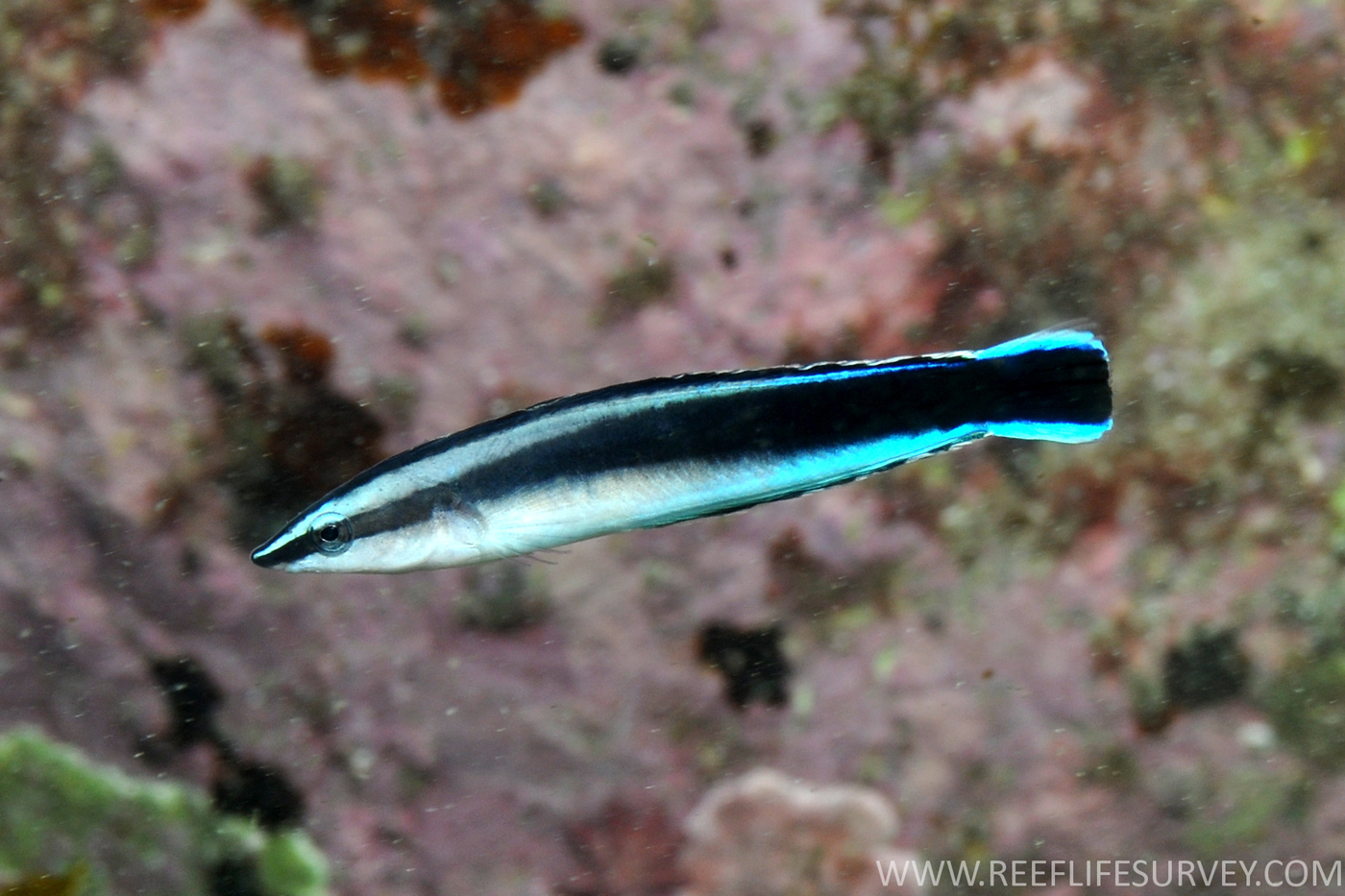False Cleanerfish, Aspidontus taeniatus Quoy & Gaimard 1834
Other Names: False Cleaner, False Cleaner Fish, Mimic Blenny

A False Cleanerfish, Aspidontus taeniatus, in Jervis Bay, New South Wales. Source: Rick Stuart-Smith / Reef Life Survey. License: CC by Attribution
Summary:
A combtooth blenny that mimics the similarly coloured Common Cleanerfish, Labroides dimidiatus. The False Cleanerfish copies both the dance and appearance of the cleaner wrasse so that it can bite off pieces of the fins of unsuspecting prey. This colour pattern and behaviour also provides the False Cleanerfish with protection from predators.
Cite this page as:
Bray, D.J. 2021, Aspidontus taeniatus in Fishes of Australia, accessed 27 Jun 2025, https://fishesofaustralia.net.au/Home/species/1052
False Cleanerfish, Aspidontus taeniatus Quoy & Gaimard 1834
More Info
|
Distribution |
Shark Bay, Western Australia, to Sydney, New South Wales, including some reefs in the Coral Sea; also Cocos (Keeling) Islands and Christmas Island in the eastern Indian Ocean, and the Lord Howe Province in the Tasman Sea. Elsewhere the species occurs in the tropical Indo-west-central Pacific. |
|
Feeding |
Feeds not only on the fins of unsuspecting victims, but also on demersal fish eggs, polychaete worms and fish ectoparasites. |
|
Similar Species |
Although adult False Cleanerfish closely resemble adult Common Cleanerfish, Labroides dimidiatus, the False Cleanerfish differs in having a more pointed snout and a longer dorsal fin base. |
|
Etymology |
The specific name is from the Latin taeniatus (= ribbon-like) in reference to the prominent mid-lateral stripe of adults. |
|
Species Citation |
Aspidontus taeniatus Quoy & Gaimard 1834, Voyage de découvertes de "l'Astrolabe" Zoologie Vol. 3(2): 719, pl. 19(4). Type locality: Guam. |
|
Author |
Bray, D.J. 2021 |
|
Resources |
False Cleanerfish, Aspidontus taeniatus Quoy & Gaimard 1834
References
Allen, G.R. 1997. Marine Fishes of Tropical Australia and South-east Asia. Perth : Western Australian Museum 292 pp. 106 pls.
Allen, G.R. & Smith-Vaniz, W.F. 1994. Fishes of Cocos (Keeling) Islands. Atoll Research Bulletin 412: 1-21 (as Aspidontus taeniatus tractus)
Allen, G.R. & Steene, R.C. 1988. Fishes of Christmas Island Indian Ocean. Christmas Island : Christmas Island Natural History Association 197 pp.
Allen, G.R., Steene, R.C. & Orchard, M. 2007. Fishes of Christmas Island. Christmas Island : Christmas Island Natural History Association 2 edn, 284 pp.
Cheney, K. 2008. The role of avoidance learning in an aggressive mimicry system. Behavioral Ecology 19(3): 583–588. https://doi.org/10.1093/beheco/arn001
Cheney, K.L. 2011. Cleaner wrasse mimics inflict higher costs on their models when they are more aggressive towards signal receivers. Biology Letters 8 (1): 10–12. https://doi.org/10.1098/rsbl.2011.0687
Cheney, K., Grutter, A.S. & Bshary, R. 2014. Geographical variation in the benefits obtained by a coral reef fish mimic. Animal Behaviour 88: 85-90. https://doi.org/10.1016/j.anbehav.2013.11.006
Fowler, H.,W. 1903. Descriptions of several fishes from Zanzibar Island, two of which are new. Proceedings of the Academy of Natural Sciences, Philadelphia 55: 161-176 (described as Aspidontus tractus)
Gill, A.C. & Reader, S.E. 1992. Fishes. pp. 90-93, 193-228 in Hutchings, P. (ed.). Reef Biology. A Survey of Elizabeth and Middleton Reefs, South Pacific. Canberra : Australian National Parks Vol. 3, Kowari 230 pp.
Hastings, P. & Springer, V.G. 2009. Recognizing diversity in blennioid fish nomenclature (Teleostei: Blennioidei). Zootaxa 2120: 3-14 (as Aspidontus taeniatus and A. tractus)
Hutchins, J.B. & Swainston, R. 1986. Sea Fishes of Southern Australia. Complete field guide for anglers and divers. Perth : Swainston Publishing 180 pp.
Kuiter, R.H. 1992. Tropical Reef-Fishes of the Western Pacific, Indonesia and Adjacent Waters. Jakarta : PT Gramedia Pustaka Utama 314 pp. pls.
Kuiter, R.H. 1993. Coastal Fishes of South-eastern Australia. Bathurst : Crawford House Press 437 pp.
Kuiter, R.H. 1996. Guide to Sea Fishes of Australia. A comprehensive reference for divers and fishermen. Sydney, NSW, Australia : New Holland Publishers xvii, 434 pp.
Kuwamura, T. 1983. Reexamination on the aggressive mimicry of the cleaner wrasse Labroides dimidiatus by the Blenny Aspidontus taeniatus (Pisces; Perciformes). Journal of Ethology 1(1-2): 22–33.
Randall, J.E. 2005. A Review of mimicry in marine fishes. Zoological Studies 44(3): 299–328.
Robertson, D.R. 2013. Who resembles whom? Mimetic and coincidental look-alikes among tropical reef fishes. PLoS ONE 8(1): e54939. https://doi.org/10.1371/journal.pone.0054939
Smith-Vaniz, W.F. 1976. The saber-toothed blennies, tribe Nemophini (Pisces : Blenniidae). Monographs of the Academy of Natural Sciences of Philadelphia 19: 1-196 figs 1-179 (as Aspidontus taeniatus tractus)
Smith-Vaniz, W.F. 1987. The saber-toothed blennies, tribe Nemophini (Pisces: Bleniidae): an update. Proceedings of the Academy of Natural Sciences of Philadelphia 139: 1-52.
Smith-Vaniz, W.F., Victor, B.C. & Allen, G.R. 2020. Aggressive mimicry in Aspidontus and Plagiotremus (Pisces: Blenniidae): some mimetic phenotypes are not phylogenetically informative. Journal of the Ocean Science Foundation 35: 118-128.
Williams, J.T. 2014. Aspidontus taeniatus. The IUCN Red List of Threatened Species 2014: e.T48342346A48351918. https://dx.doi.org/10.2305/IUCN.UK.2014-3.RLTS.T48342346A48351918.en. Downloaded on 09 July 2021.







